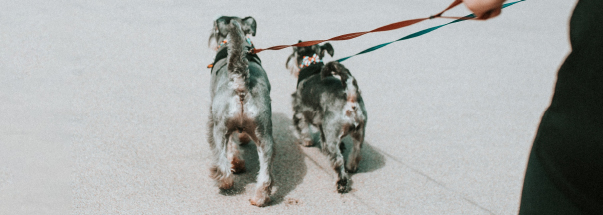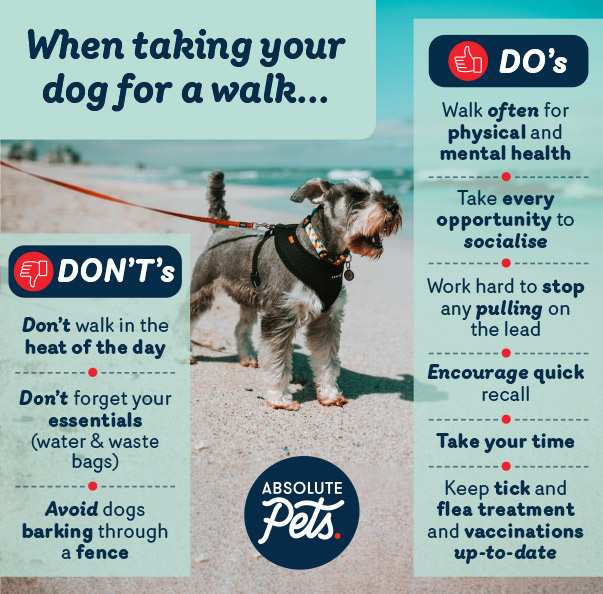
Walking your dog can be one of the highlights of your day but, for some, it can also be a little stressful. How can you get your dog to stop pulling on the lead? How can you encourage them to stay with you and come back when called? We chatted to certified dog behaviourist and trainer Ludovica Barnato and below you’ll find her Do’s and Don’t’s for dog walking.
DO…
1. Walk often for physical and mental health
Most dogs need to leave the house for a walk at least once a day (twice a day if you live in a flat). Taking them for a walk isn’t just about exercise (and thereby helping to keep to their optimum weight), it’s also about their mental health. Getting out and about will ease levels of frustration and quite simply improve their happiness. For very anxious or aggressive dogs, a different approach may be required (e.g. steering clear of any ‘triggers’ like other dogs and barking). Some breeds are also super active and will need to get out of the house more and incorporate longer runs into their daily routine.
One of the most common misconceptions is that if you have a garden, you don’t need to walk your dog. Walking your dog allows essential stimulation – a way to sniff and explore the world around them; to let off energy and to be sociable with other dogs and people.
2. Take every opportunity to socialise
Being out and about in the park, on the trails or at the beach gives your dog a good chance to socialise. For a puppy (with vaccinations up to date), this is essential. The more they can socialise in the first few months of life, the better. If you have an older dog who is not sociable, we highly recommend seeking the help of an animal behaviourist. He or she will be able to help you understand your dog’s behaviour and triggers. A vet’s help may be required too.
3. Work hard to stop any pulling on the lead
For a puppy or dog to walk well on the lead, hours and hours of training and practice are required. Ideally you want to aim for your dog to be able to walk on a loose leash. There are so many ways to teach this behaviour. One way is to stop or very quickly change direction as soon as your dog pulls away from you. When your dog joins you again and the leash isn’t tight, you can reward them with a treat. This will take a lot of practice and patience, but the goal is to make it feel like a game in which your dog never really knows which direction you'll go in next, so they need to stay with you and, if they do, they know they’ll be rewarded. For loose lead training and quick recall, puppy classes are key, with everything you do and try to teach your dog aimed at building a close bond between you and your pet so they will always be excited to be with you.
When first walking with a puppy, keep him or her on a leash and focus on rewarding good behaviour, use simple commands like ‘watch me’, and play fun games with them.
4. Encourage quick recall
Ideally, you’ll want to be able to let your dog off the lead when you’re in a safe place in which they can run and play. It’s best to practice this at home using treats and positive reinforcement and it’s never too early to start. Always praise and reward your dog when he or she comes back to you. Play games like tug of war, hide and seek or get the whole family involved – be consistent so they know that coming back to you is always the best idea! Even at home, when your dog comes to you naturally without being called, reward this behaviour.
5. Take your time
Walking your dog is also a time for them to sniff around and explore (sniffing is so important – it has a calming effect on the brain and it’s how they learn about the world around them). It’s also a great opportunity to bond, so take a ball or a toy that can be used for a game of fetch or anything else that can add to the fun! If your dog is able to be off the lead, check your expectations, as they might not come back to you if they’ve just met some new friends!
6. Keep tick and flea treatment & vaccinations up-to-date
Keep your dog safe from nasty parasites when you’re out on walks. Remember to keep their routine vaccinations and tick & flea treatments up to date. This is the easiest way to prevent any nasty health complications. Download our routine care guide here and find out more about tick & flea treatments here.
DON’T…
7. Don’t walk in the heat of the day
If it’s hot outside, be aware that the road can heat up so much that it can burn the paws of your dog. Morning and evening walks on hot days are best.
8. Avoid dogs barking through a fence
When you’re short of time (and space), it’s often easier to take your dog for a quick walk around the block. Be wary of dogs barking fiercely through a fence. This can lead to anxiety in your dog or encourage them to bark too.
9. Don’t forget your outdoor essentials
If you’re heading out and it’s hot or going for a long walk, take some water with you for your dog. This Olly & Max Travel Water Carrier works well. Make sure you also have poop bags (check out our Olly & Max biodegradable waste bags here) and of course some tasty treats.

Recommended products for walking with your dog:
Having the right gear for walking your dog is always key. Here are our walking essentials:
A big thanks to Ludovica Barnato for sharing her expertise with us.
Stay in touch!
Remember, we are also here to help so visit your local Absolute Pets store or get in touch with us online, or on Facebook should you have any questions.
Happy & Healthy
Absolute Pets